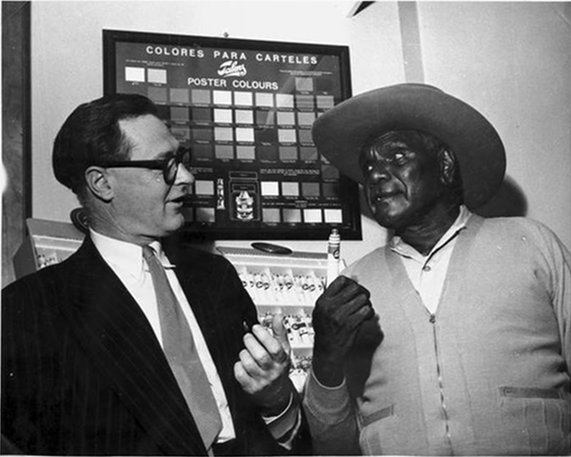|
Contemporary Indigenous Australian Art
Contemporary Indigenous Australian art (also known as contemporary Aboriginal Australian art) is the modern art work produced by Indigenous Australians, that is, Aboriginal Australians and Torres Strait Islander people. It is generally regarded as beginning in 1971 with a painting movement that started at Papunya, northwest of Alice Springs, Northern Territory, involving Aboriginal artists such as Clifford Possum Tjapaltjarri and Kaapa Tjampitjinpa, and facilitated by white Australian teacher and art worker Geoffrey Bardon. The movement spawned widespread interest across rural and remote Aboriginal Australia in creating art, while contemporary Indigenous art of a different nature also emerged in urban centres; together they have become central to Australian art. Indigenous art centres have fostered the emergence of the contemporary art movement, and as of 2010 were estimated to represent over 5000 artists, mostly in Australia's north and west. Contemporary Indigenous artists ha ... [...More Info...] [...Related Items...] OR: [Wikipedia] [Google] [Baidu] |
Indigenous Australians
Indigenous Australians or Australian First Nations are people with familial heritage from, and membership in, the ethnic groups that lived in Australia before British colonisation. They consist of two distinct groups: the Aboriginal peoples of the Australian mainland and Tasmania, and the Torres Strait Islander peoples from the seas between Queensland and Papua New Guinea. The term Aboriginal and Torres Strait Islander peoples or the person's specific cultural group, is often preferred, though the terms First Nations of Australia, First Peoples of Australia and First Australians are also increasingly common; 812,728 people self-identified as being of Aboriginal and/or Torres Strait Islander origin in the 2021 Australian Census, representing 3.2% of the total population of Australia. Of these indigenous Australians, 91.4% identified as Aboriginal; 4.2% identified as Torres Strait Islander; while 4.4% identified with both groups. [...More Info...] [...Related Items...] OR: [Wikipedia] [Google] [Baidu] |
Judy Watson
Judy Watson (born 1959) is an Australian Waanyi multi-media artist who works in print-making, painting, video and installation. Her work often examines Indigenous Australian histories, and she has received a number of high profile commissions for public spaces. Early life and education Judy Watson was born in Mundubbera, Queensland in 1959. She is a Brisbane-based Waanyi artist. She was educated at the Darling Downs Institute of Advanced Education in Toowoomba, where she received a Diploma of Creative Arts in 1979; at the University of Tasmania where she received a bachelor's degree (1980–82); and at Monash University, where she completed a graduate diploma in 1986. At Tasmania University she learned many techniques, among them lithography, which has influenced her entire body of work. Career Watson trained as a print-maker, and her work in painting, video and installation often relies upon the use of layers to create a sense of different realities co-existing. As an Aborig ... [...More Info...] [...Related Items...] OR: [Wikipedia] [Google] [Baidu] |
Wood Carving
Wood carving is a form of woodworking by means of a cutting tool (knife) in one hand or a chisel by two hands or with one hand on a chisel and one hand on a mallet, resulting in a wooden figure or figurine, or in the sculptural ornamentation of a wooden object. The phrase may also refer to the finished product, from individual sculptures to hand-worked mouldings composing part of a tracery. The making of sculpture in wood has been extremely widely practised, but doesn't survive undamaged as well as the other main materials like stone and bronze, as it is vulnerable to decay, insect damage, and fire. Therefore, it forms an important hidden element in the art history of many cultures. Outdoor wood sculptures do not last long in most parts of the world, so it is still unknown how the totem pole tradition developed. Many of the most important sculptures of China and Japan, in particular, are in wood, and so are the great majority of African sculpture and that of Oceania and ... [...More Info...] [...Related Items...] OR: [Wikipedia] [Google] [Baidu] |
Sculpture
Sculpture is the branch of the visual arts that operates in three dimensions. Sculpture is the three-dimensional art work which is physically presented in the dimensions of height, width and depth. It is one of the plastic arts. Durable sculptural processes originally used carving (the removal of material) and modelling (the addition of material, as clay), in stone, metal, ceramic art, ceramics, wood and other materials but, since Modernism, there has been an almost complete freedom of materials and process. A wide variety of materials may be worked by removal such as carving, assembled by welding or modelling, or Molding (process), moulded or Casting, cast. Sculpture in stone survives far better than works of art in perishable materials, and often represents the majority of the surviving works (other than pottery) from ancient cultures, though conversely traditions of sculpture in wood may have vanished almost entirely. However, most ancient sculpture was brightly painted, ... [...More Info...] [...Related Items...] OR: [Wikipedia] [Google] [Baidu] |


